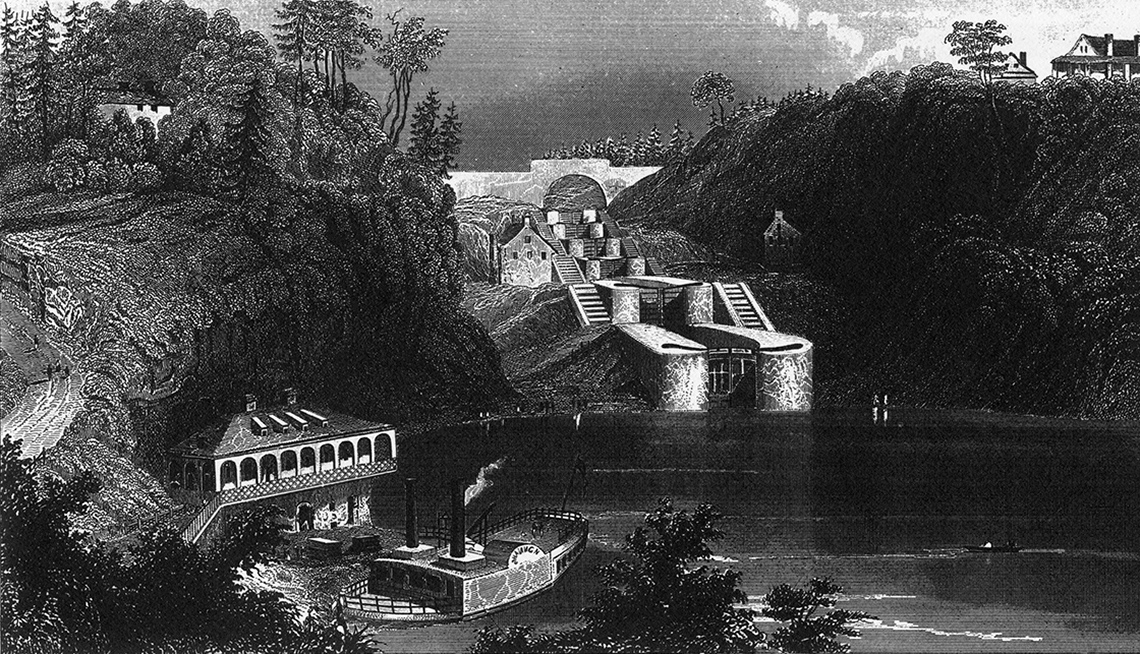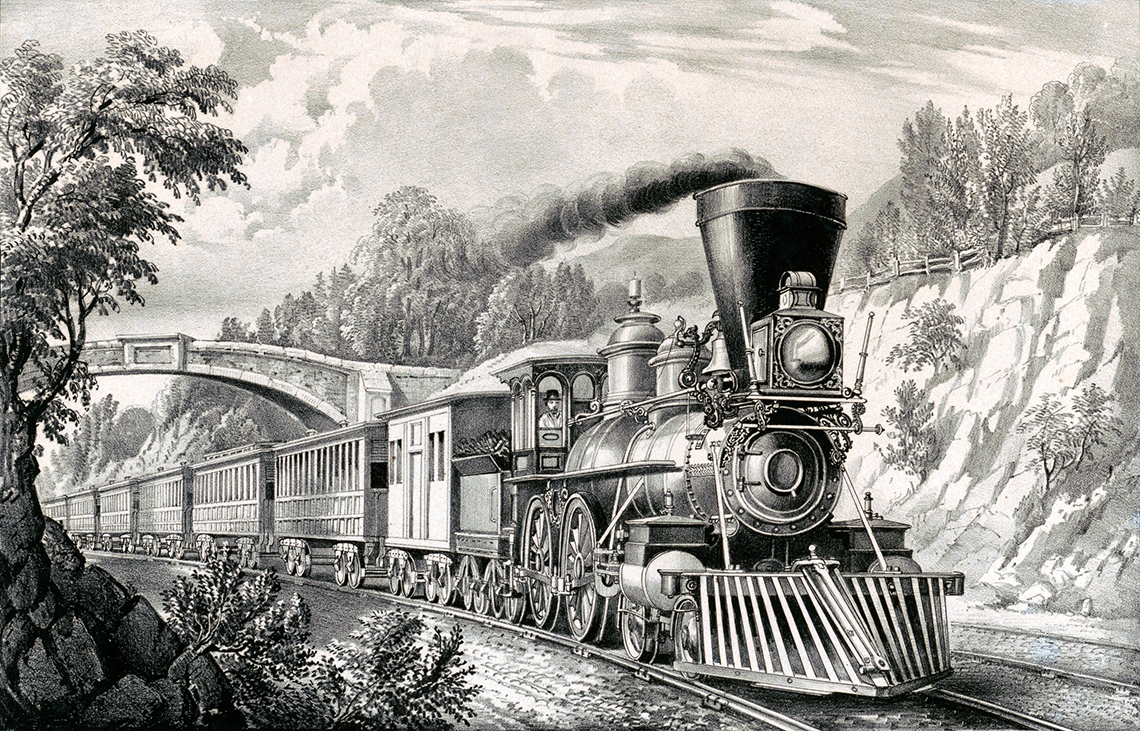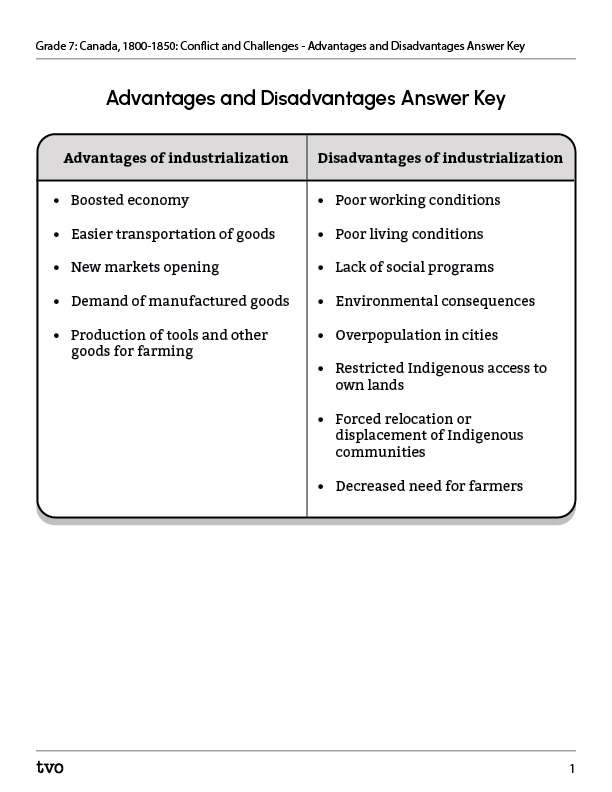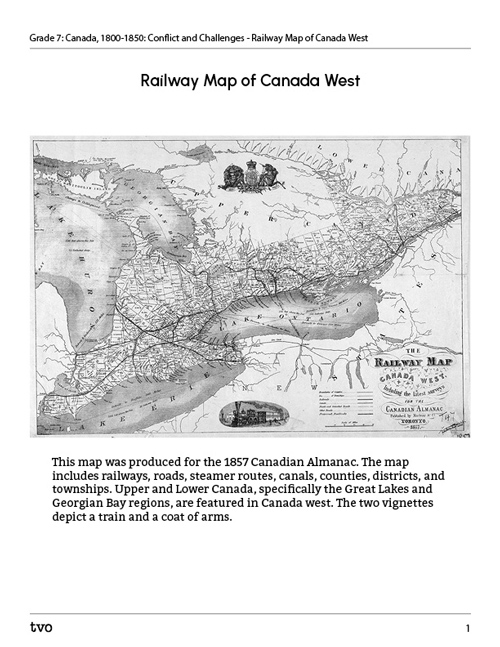Minds On
Something to think about!
Student Success
Think-Pair-Share

Consider how technology has advanced over time. Brainstorm a list of inventions or technological advancements that you think have occurred in the last 100 years.
Share this list with peers if possible. Were there any ideas that everyone had that were the same? Anything stand out? What impact does technology have on our modern world?
Note to teachers: See your teacher guide for collaboration tools, ideas and suggestions.
Action
What is industrialization?

Industrialization is the process by which an economy is transformed from a primarily agricultural industry to an economy based on manufacturing and mass production. In this learning activity, you will explore the first Industrial Revolution that took place in Canada between 1800 and 1850 and the major effects it had on the development of Canada.
Press ‘More Information’ to learn more about industrialization.
Before the Industrial Revolution, most of the population in Canada lived on farms or in villages called cottage countries, which often involved spinning and weaving.
Changes in technology allowed the development of mass production and large-scale farming that created a surplus of goods that could be distributed by railways and canals. As technology advanced, people were forced to move to the cities for work opportunities.Task 1: Canals and railways
The development of canals
In the 1830s, the excitement of canals was fed by a demand for locally-produced goods to be shipped to other locations. Between 1821 and 1825 the first real canal was built called The Lachine Canal on the St. Lawrence River. The canal bypassed the Lachine rapids, which for a long time were barriers to navigation. The Lachine Canal became the port of exit for goods coming out of Upper Canada, which boosted the economy. The water flow of the canal was strong enough that it generated power through water wheels, and eventually industries (sawmills, flourmills) relocated to take advantage of that power supply.
Many of these canals were publicly financed and the facilities were operated by the government. From 1834 to 1850, the Ottawa River canals and the Rideau Canal, with the rivers they served, constituted the seaway.

While canals were major technological advancements at the time, they had some limitations, as many months of the year the water was frozen. Only so much grain could be shipped at the end of an autumn harvest before the canals froze over and the harvest would have to wait until spring before sending it to the market. Canal-related debt was high, which left the government of Upper Canada unable to fund other projects, like road construction. Some people proposed higher taxes to help pay for the canals, while others insisted trade be taxed to cover the cost.
Source: Leggett , R. F. (2006, February 6). Canals and Inland Waterways. Canals and Inland Waterways | The Canadian Encyclopedia. https://www.thecanadianencyclopedia.ca/en/article/canals-and-inland-waterways.
Source: Belshaw, J. D. (2015, April 13). 9.7 The Canal Era. Canadian History PreConfederation. https://opentextbc.ca/preconfederation/chapter/9-7-the-canal-era/.
Learning check!
Let's check our understanding about the development of canals in Canada.
Decide if the statement is ‘True’ or ‘False’ and then press ‘Check Answer’ to find out if you got it correct.
Railway development
In 1845, the biggest driver of economic change was the railway development. This development was a very effective means of moving goods and people and were considered the mark of an up-to-date economy. They were an advancement from waterways because they could be used year-round and wouldn’t suffer from the cold weather. They could also be built wherever they were needed and were not reliant on large bodies of water to function. One of the first true railways appeared in Canada in the 1830s.

It did not take long for politicians to realize the potential benefits of railways as Canada is a very large country with poor road conditions and waterways that could not be used in the winter. In 1849, governments began offering grants (The Guarantee Act) to railways that were more than 125 kilometers long that guaranteed up to 6% interest once the railways were complete.
Source: Marsh, J. H. (2009, March 25). Railway History in Canada. The Canadian Encyclopedia. https://www.thecanadianencyclopedia.ca/en/article/railway-history.
Learning check!
Let's check our understanding about the development of railways in Canada.
Decide if the statement is ‘True’ or ‘False’ and then press ‘Check Answer’ to find out if you got it correct.
Review questions
Answer the following questions to help review your learning:
- What do you think were some of the perceived benefits of railways?
- Which development (the canal or railway) do you believe had a more significant impact on Canada? Why?
Record your answers using a method of your choice.
Press ‘Hint’ to access help getting started.
Task 2: Technological advancement inquiry
Press ‘Inquiry’ to access the definition.

This is a diagram of the Inquiry Process. The five major steps are: “Interpret and Analyze” “Gather and Organize” “Formulate Questions” “Evaluate and Draw Conclusions”, and “Communicate.” Interpret and Analyze: Analyze the data, evidence, and information, using different types of graphic organizers as appropriate. Gather and Organize: Collect and organize relevant data, evidence, and/or information from primary and secondary sources and/or field studies. Formulate Questions: Formulate questions related to the applicable overall expectation in order to identify the focus of their inquiry. Evaluate and Draw conclusions: Synthesize data, evidence, and/or information, and make informed, critical judgements based on that data, evidence, and/or information. Communication: Communicate judgements, decisions, conclusions, predictions, and/or plans of action clearly and logically.

In this task, you will be investigating one of the technological advancements that were introduced in Canada between 1800 and 1850. Follow the inquiry steps provided to help conduct your investigation.
Possible choices for technological advancement
- spinning jenny
- steam power or steam engine
- railways
- canals
- iron ships
- manufacturing tools
- mining (coal, iron ore)
Begin your research by exploring government websites and databases, virtual museums, and Canadian encyclopedias. When you are finished investigating, you will design an advertisement for your technological advancement.
Create a poster style (in print or digitally) advertisement that highlights your technological advancement, and the impact it had on the Canadian economy.
As you complete this activity, use the following criteria checklist to evaluate your poster.
My advertisement has:
Task 3: Assessing the impact
Press the following tabs to access information about the impacts of the first Industrial Revolution in Canada.
Certain cities were further established by their railway connections, opened up new markets, and created a demand for other manufactured goods. The development of the railway boosted other industries, such as hotels, and ultimately paved the path to Confederation. While the Industrial Revolution brought great wealth to some, it also brought great poverty to others.
A railway map of Canada West is provided after the tabs for you to explore.
Examine the following Railway Map of Canada West document.
This map was produced for the 1857 Canadian Almanac. The map includes railways, roads, steamer routes, canals, counties, districts, and townships. Upper and Lower Canada, specifically the Great Lakes and Georgian Bay regions, are featured in Canada west. The two vignettes depict a train and a coat of arms.
Test your Skills!
Advantages and Disadvantages
Now that you have learned about industrialization, complete Industrialization in Canada: Advantages and Disadvantages in your notebook or in the following printable and fillable document. You may also use a method of your choice.
|
Advantages of industrialization |
Disadvantages of industrialization |
|---|---|
|
Place the following responses in the correct column
|
|
Press the ‘Activity’ button to access the Industrialization in Canada: Advantages and Disadvantages.
To review your answers, examine the following Advantages and Disadvantages Answer Key document.

Press the Activity button to access the Advantages and Disadvantages Answer Key.
Activity(Opens in a new tab)Consolidation
Task 1: Pros and cons
In this learning activity, you have explored the first Industrial Revolution in Canada, including the development of canals and railways. Consider what you have learned and create a pros and cons list of the Industrial Revolution using the following fillable and printable document or using a method of your choice.
|
Pros – What were some of the positive outcomes for Canada and its peoples? |
Cons – What were some of the negative outcomes for Canada and its peoples? |
|---|---|
Press the ‘Activity’ button to access the Pros and Cons List.
Review question
Answer the following question to review what you have learned:
- What social and economic impact did the Industrial Revolution have on Canada?
Record your answer using a method of your choice.
Task 2: Create your own technological advancement

Consider modern-day Canada and the technological advancements that have been made and how these advancements have shaped the modern world we live in today.
Create your own technological advancement and explain what impact it would have on Canada. Consider how your advancement would help improve modern day society and what negative impacts it might cause.
If possible, “pitch” your technological advancement to your class!
Reflection
As you read the following descriptions, select the one that best describes your current understanding of the learning in this activity. Press the corresponding button once you have made your choice.
I feel...
Now, expand on your ideas by recording your thoughts using a voice recorder, speech-to-text, or writing tool.
When you review your notes on this learning activity later, reflect on whether you would select a different description based on your further review of the material in this learning activity.
